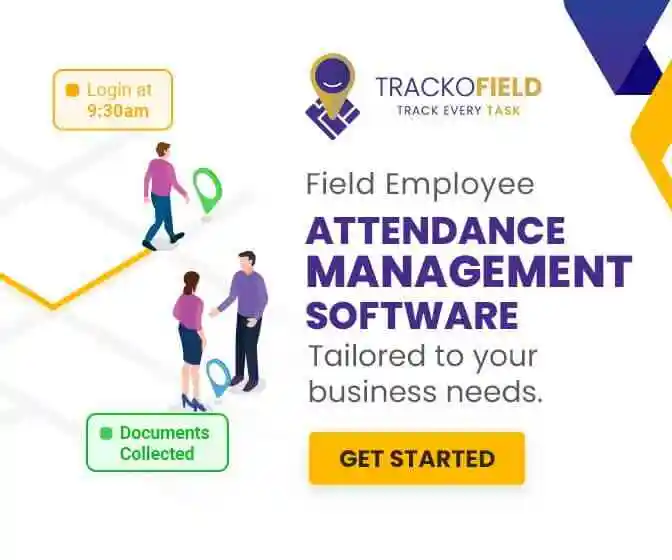-
TrackoBit
Manage commercial vehicles with the new-age Fleet Management Software
TrackoBit -
TrackoField
Streamline your scattered workforce with Field Force Management Software
TrackoField -
Features Resources
-
Blog
Carefully curated articles to update you on industrial trends. -
White Paper
Insightful papers and analysis on essential subject matters. -
Glossary
Explore an alphabetical list of relevant industry terms. -
What’s New
Get TrackoBit & TrackoField monthly updates here. -
Case Study
Explore the cases we solved with our diverse solutions. -
Comparisons
Compare platforms, features, and pricing to find your best fit.
-
About Us
Get to know TrackoBit: our team, ethos, values, and vision. -
Careers
Join the most dynamic cult of coders, creatives and changemakers. -
Tech Support
Learn about our technical support team and services in detail. -
Events
Check out the exhibitions where we left our marks and conquered. -
Contact Us
Connect with us and let us know how we can be of service.
7 Strategies Agri Brands Use to Stay Visible in Remote Markets
- Author:Mudit Chhikara
- Read Time:7min
- Published:
- Last Update: December 11, 2025
Table of Contents
Toggle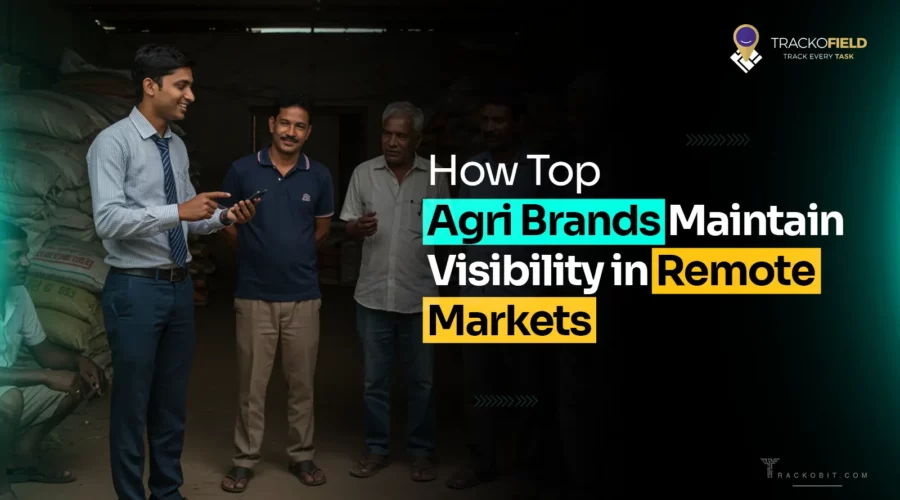
Let’s learn how agri brands overcome location and connectivity challenges to maintain visibility in remote agri markets.
Table of Contents
Toggle
One of the biggest challenges for agri-input brands is maintaining visibility in remote or rural markets. These areas are often isolated, lack network connectivity, have poor transportation facilities and rigid social norms.
This makes it difficult for agri brands to establish a strong presence and benefit the local farmers with latest agri inputs.
However, difficult doesn’t mean impossible!
Agri-brands rely on innovative strategies, field force automation software and ground-level engagement with farmers, dealers and retailers to maintain visibility in remote markets.
Dive in to learn more.
How Agri Brands Ensure High Visibility in Remote Markets – 7 Key Strategies
1. Targeted Sales & Marketing
Every region has its own local customs, harvest seasons, festivals and agricultural preferences. Therefore, a “one-size-fits-all” approach to agri-input marketing is ill-suited.
Agri brands need to tailor their selling and marketing approach to local preferences to improve their visibility. Ask yourself, what will a farmer choose:
An agri brand selling a generic product
Or the brand selling a unique and personalised product?
We’re certain you will choose the latter!
💡 Agri-input products with custom packaging, competitive pricing, and local language branding are more appealing to farmers. Leading brands invest in understanding regional customs to tailor their marketing strategies.
Some more integrations leading brands are doing:
- A leading fertiliser brand promotes a mobile app that tracks fertilizer usage. This helps them provide customized recommendations based on the farmer’s crops and soil conditions.
- Whereas an agro-chemical brand was using QR codes that links farmers to some extra product information, agrochemical usages or promotional offers.
- Some brands are even using personalised labels with farmer’s name, farm name, or a unique design elements.
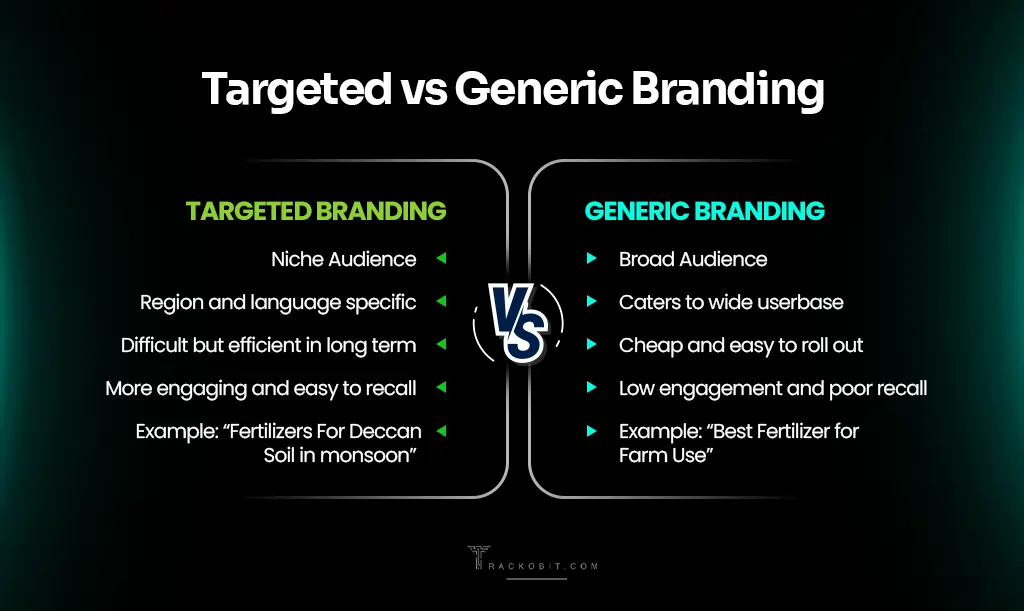
Targeted vs Generic Branding
2. Building Strong Dealer and Retailer Networks
Agri input products are made to benefit farmers. But these farmers don’t directly buy from your outlets. Your products need to be available at every possible retailer or dealers’ outlets. It’s the retailers and local dealers who will better help in promoting or selling your agri-inputs in rural agricultural markets or mandis.
This is due to the fact that local farmers trust retailers as they have existing relationships with them. Thus, retailers and dealers serve as the primary point of contact between the agri input brand and the farmer. They also provide on-ground insights to agri brands to improve their products and campaigns.
Therefore, it becomes necessary for agri brands to form strong relationships with retailers and dealers. This is achieved by:
- Providing them with incentives, training, and marketing support.
- Ensuring consistent communication through WhatsApp, SMS, or on-ground field visits.
- Onboarding local retailers and dealers as local brand ambassadors.
3. Seamless Digital Communication
Top agri brands are ditching slow, outdated modes of communication and using mobile-based platforms for rapid information transfer. Agri sales agents nowadays store retailer information in their field force automation mobile app.
They can contact retailers through WhatsApp, Telegram, SMS or other methods using the app itself. This allows quick and easy two-way communication between retailers and agri input businesses.
Both parties can communicate in regional languages and even share voice notes, media files and documents. Many agri-brands also use push notifications and alerts. Thus, retailers can be informed of pricing updates, new developments and tips in real time.
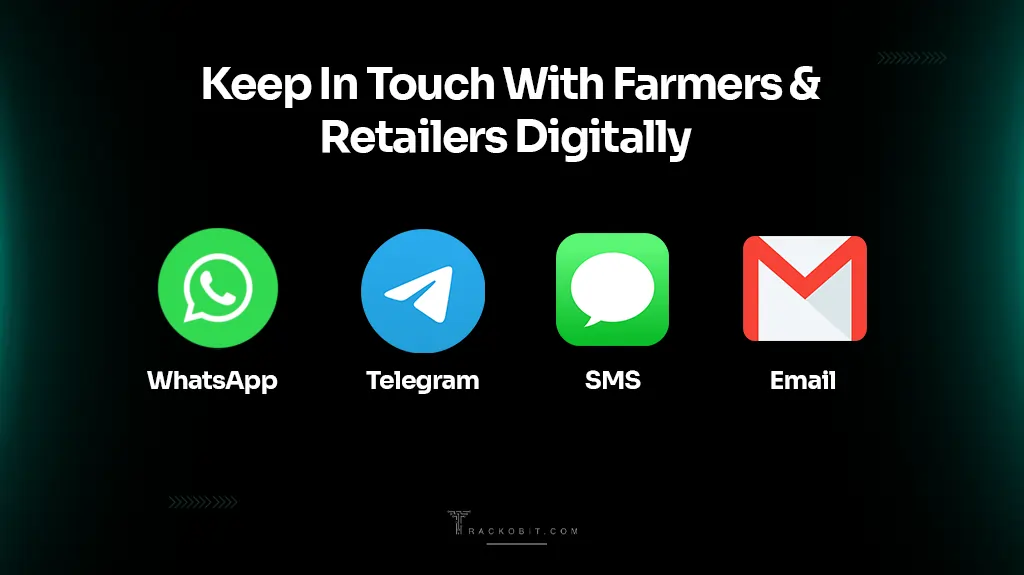
Keep In Touch With Farmers & Retailers Digitally
4. Demonstration-Led Marketing
Growing a crop is a huge investment of capital, labour and time. That’s why farmers prefer tried-and-tested agriculture practices instead of trying new agri inputs.
Simply stating benefits of your agri inputs is not an effective sales tactic in the agri business and usually fails to change farmers’ minds.
What is a good agri-sales tactic?
Demonstrations!
Yes, nothing helps sell an agri input product like a good demonstration.
- Want to sell a tractor or machinery? Show it in use live, how it works, its ease of use and benefits.
- Want to sell seeds, fertilizers, pesticides, etc.?
Offer free samples or provide videos or pamphlets of reliable success stories.
Agri-brands can increase their reach using social media as well. They can upload clips of live demos at farmer gatherings, mandis, workshops, etc.
5. Experiential Marketing for Brand Recall Strategies
Top brands make sure their presence is felt even when they aren’t physically there. How? Through high-visibility, long-lasting branding material and advertising in strategic locations.
They are opting for:
- Wall paintings and murals in villages, advertising their products.
- Branded signage on shops, fertilizer sheds, and godowns to increase awareness.
- Product stickers or sacks with bold logos.
- Distribution of free branded utility items like umbrellas, wall clocks, and calendars.
These touchpoints help build agri brand familiarity and trust over time.
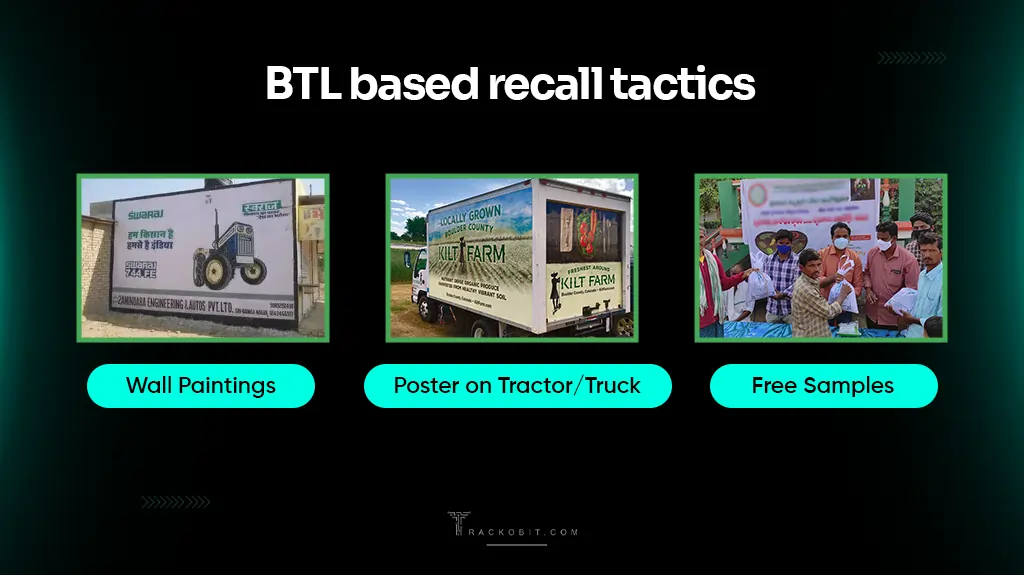
Brand Recall Strategies for Agri Inputs
6. Consistent Field Teams’ Presence
On-field agri input marketing agents are the lifeline of rural brand visibility. They carry out product demos, build relationships with dealers and farmers, and collect vital feedback from the ground. They also assist in sales, farmer onboarding, and troubleshoot machinery.
Here’s how they are improving penetration into remote agri markets by effectively using field workforce.
- Tracking field reps for different regions.
- Aligning agents’ daily visits, beat plans, targets with priority.
- Ensuring regular outreach and follow-ups, not just during launch seasons.
To streamline and scale this process, popular brands are integrating field force tracking software like TrackoField to:
- Track agri agents’ location and activity in real-time.
- Ensure optimum coverage across targeted villages, mandis or territories.
- Digitally log visits, feedback, and order collections.
7. Data-Led Rural Penetration Strategy
The agriculture market is everchanging. Agri brands need to evolve with time as well. The strategy you used two years ago may not be applicable now. To be successful, you need to collect and analyse the following data from the field:
- Area-wise product demand
- Farmer behaviour, preferences & pain points
- Villages lacking dealer coverage
- Trending agri input queries and complaints
- Competitor analysis and market positioning
This data is collected in various ways. Agri agents gather feedback from farmers, dealers and retailers. This helps understand their challenges, queries, market trends and competitors’ strategies. Field force tracking software also records other data like area-wise visits, appointments, inventory use, product demands, etc.
This data-first approach helps refine rural marketing strategies, campaigns, optimize field force allocation, and maximize ROI in remote regions.
Wrapping Up
Building brand visibility in remote markets is no cakewalk. Agri input companies face hurdles like rigid social norms, poor network connectivity, inadequate transportation facilities, etc.
That’s why you need a unique approach to build your brand visibility and sell agri inputs in rural markets. From giving product demos and engaging with retailers or dealers to integrating advanced tech and using targeted marketing, agri brands must adopt a 360-degree approach.
It’s also important to empower your workforce with activity tracking tools. Field force automation can help optimise agri agents’ field tasks and speed up key processes like farmer onboarding and on-ground data collection.
Book a free demo of TrackoField to learn more!
FAQs
-
Why do agri brands struggle with visibility in remote markets?
Agri brands struggle with visibility in remote markets mainly due to: - Poor infrastructure & high transport costs. - Scattered and small customer bases. - Limited media reach (TV, digital, print). Also, rural farmers often rely on traditional trust networks (local dealers, fellow farmers) rather than advertising. Thus, they are not easy to convert.
-
Is offline data sync important for field teams in remote areas?
Yes, offline data sync is critical for agri sales operations as it ensures seamless field operations. Many remote regions have poor or no internet connectivity. Without offline capability, field staff can't record visits, collect farmer data, or update activities until they find a network. It can result in errors, miscommunication, loss of data, and demotivation.
-
How can field force management tools help agri brands improve reach in rural markets?
Field force management tools can help agri brands by enabling better planning, monitoring, and execution of field activities. These tools allow brands to manage farmer meetings, product demos, and retailer visits in a systematic way. Managers can also track team movements, collect real-time feedback, and measure campaign effectiveness.
-
Can GPS tracking improve agri sales team productivity?
Yes, GPS tracking can significantly improve your agri sales teams’ productivity. It ensures that agents are visiting the assigned locations, spending the right amount of time with farmers, and covering their territories properly. GPS also enables better route planning, reduces time wastage, and discourages false reporting.
Mudit is a seasoned content specialist working for TrackoField. He is an expert in crafting technical, high-impact content for Field force manage... Read More
Related Blogs
-

Unified Field Workforce Dashboard: Monitor Tasks, Attendance & More In One Place
Mudit Chhikara December 15, 2025Bring full clarity to field operations with a single, real-time field workforce dashboard.
-

Loan Disbursement in NBFCs: From 15 Days to 3 Minutes – Learn How
Shemanti Ghosh December 11, 2025TrackoField’s AI-enabled field force automation software speeds up loan disbursals in NBFC with field agent task monitoring and facial attendance…
-

AI Facial Recognition Attendance: A Game-Changer for Fraud-Free Field Operations
Mudit Chhikara December 9, 2025Ensure transparent attendance and eliminate fraud before it even starts with AI facial recognition and geofencing.
-
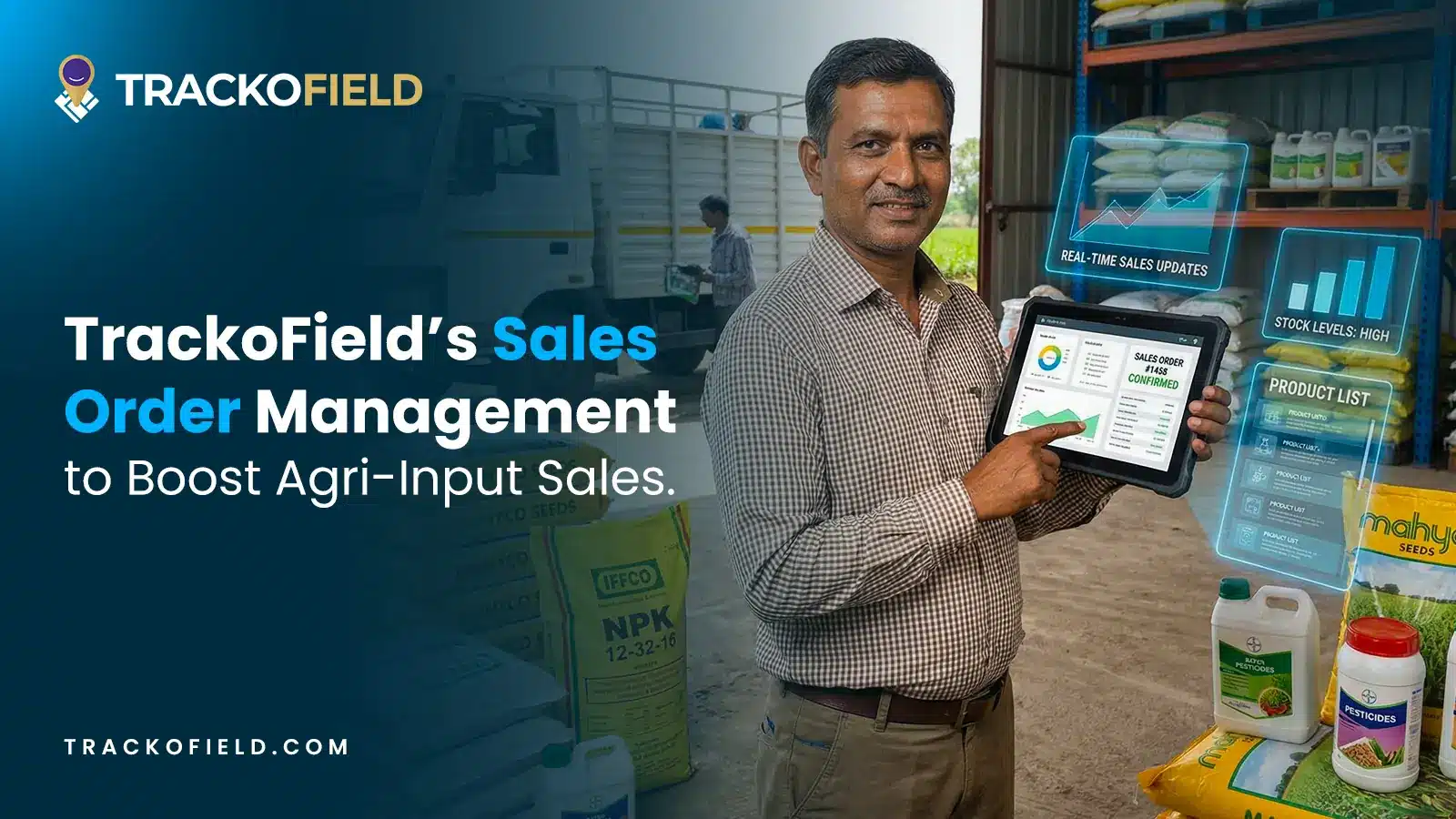
Boost Agri-Input Sales Efficiency with TrackoField’s Sales Order Management Module
Shemanti Ghosh December 3, 2025Grow Agri-input sales and expand farmer database with TrackoField’s Sales Order Management module.

Subscribe for weekly strategies to boost field team productivity.
Your inbox awaits a welcome email. Stay tuned for the latest blog updates & expert insights.
"While you're here, dive into some more reads or grab quick bites from our social platforms!"Stay Updated on tech, telematics and mobility. Don't miss out on the latest in the industry.
We use cookies to enhance and personalize your browsing experience. By continuing to use our website, you agree to our Privacy Policy.


































